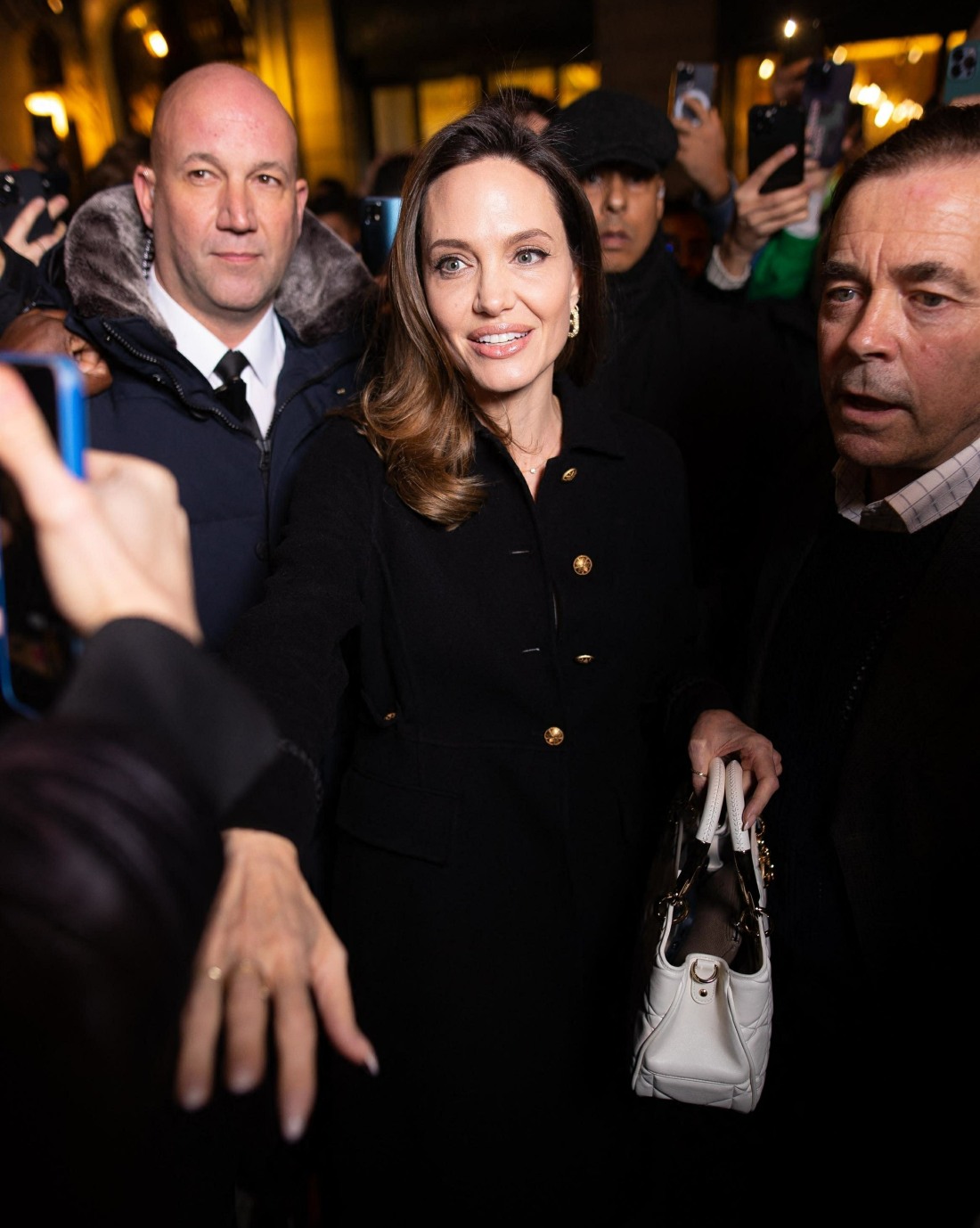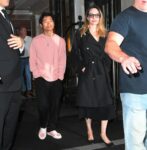Angelina Jolie has been the face of Guerlain for years now, and that job came with an additional title: Guerlain’s Godmother of the Women for Bees Program. That job is probably why she agreed to the Guerlain gig in the first place. Angelina is all about bees and resuscitating the bee population, which is in decline. She wants women to get more involved in beekeeping and being generally friendly to the bee population. To promote the Women for Bees Program, Angelina chatted with Elle Magazine. Some highlights from this excellent piece:
She’s always liked bees: “I have always liked bees. I’ve never had a fear of bees, and I’m not allergic. I tend to lean toward the creatures in the world that are a little bit misunderstood. But I have grown in my admiration and respect for these beautiful little creatures over the years, as I’ve gotten to know more about their importance—the way they exist in community and what they contribute to our lives.”
Her interconnected work in Cambodia: “[I learned more about bees] in Cambodia. I have a home and a project [through the Maddox Jolie-Pitt Foundation] where I’ve been working with communities, and looking after the forests and the protection of land and wildlife for over 20 years. I started it a long time ago in a place in Samlout, which was the first and last stronghold of the Khmer Rouge. It was a very heavily mined area on the border of Thailand. My son [Maddox] is Cambodian, and initially I thought that I would work in this area on de-mining, and learn a bit about the local people. I hoped to contribute in a good way and just be a good neighbor. Then I learned more about deforestation and the threats to the environment. Now the project has grown, and we’re working with the rangers and the protection groups to better understand what it means as it relates to biodiversity. What is in danger? When you live hand in hand with the local farmers, you learn that bees are essential to pollinating. [Beekeeping] is a very good skill and livelihood for a lot of the farmers we work with.”
A Mayan bee mission: “Recently, we were with the Mayan women in the Santa Clara community. When you discuss pollination and biodiversity, it very quickly ties to a culture of people, a history. Mayan communities have hives, and they use the honey for medicinal purposes, for beauty, and as a food. My job is to be a part of the training, and to bring people together and to participate and help support it. Sometimes, it’s working to get an education myself on the cultural heritage, the community, and the environment, and also to educate others on what I’m learning. I also get to work on training with little kids, and we get to talk about bees and do ‘bee school.’ It’s wonderful.”
On personal beekeeping: “I do bee-keep at our home in Cambodia. In Los Angeles, I have adapted my garden for the bees, with flowers and plants that are rich in pollen and nectar.”
What she thinks of self-care: “It’s not the center of my day. But I think education is an important part of self-care. That’s where I’m happiest. If I feel that I’ve enriched my mind or a relationship with somebody through something I’ve learned or experienced, then I feel that I’m growing. For me personally, I don’t wake up and have a real self-care agenda, like what is often considered self-care today. I think it’s wonderful for people who can do that or if that is their way. Everybody has their own version. I like to feel like I’m growing emotionally or intellectually—that’s my self-care. So I guess I do [it], but it’s not so much a face cream.”
Her answer about self-care is so real and so blunt. She’s like, I don’t have time for mindfulness, I’m too busy educating myself about bees and refugees. Still, I would love to know what face cream she uses?? Her skin glows like she’s being lit from within. It’s probably not a drugstore brand, sob. I also loved her answer about how her work in Cambodia has shifted over time – I remember when she first bought that huge tract of land in Cambodia and the biggest effort was de-mining the property. Then came community healthcare and environmental preservation, and now pollination. It’s fascinating. “When you discuss pollination and biodiversity, it very quickly ties to a culture of people, a history.” I’ve truly never thought about it in those terms. Angelina is so f–king cool.
Photos courtesy of Backgrid.
- New York, NY – The movie star was out for errands in NYC alongside her daughter Zahara and Angelina stuns in a black overcoat and wide-leg pants paired with leather booties. Pictured: Angelina Jolie BACKGRID USA 11 JANUARY 2023 BYLINE MUST READ: Ulices Ramales / BACKGRID USA: +1 310 798 9111 / usasales@backgrid.com UK: +44 208 344 2007 / uksales@backgrid.com *UK Clients – Pictures Containing Children Please Pixelate Face Prior To Publication*
- Paris, FRANCE – Actress Angelina Jolie visits the Guerlain Boutique at Champs Elysees in Paris, France. Pictured: Angelina Jolie BACKGRID USA 30 JANUARY 2023 BYLINE MUST READ: Best Image / BACKGRID USA: +1 310 798 9111 / usasales@backgrid.com UK: +44 208 344 2007 / uksales@backgrid.com *UK Clients – Pictures Containing Children Please Pixelate Face Prior To Publication*
- Paris, FRANCE – Actress Angelina Jolie visits the Guerlain Boutique at Champs Elysees in Paris, France. Pictured: Angelina Jolie BACKGRID USA 30 JANUARY 2023 BYLINE MUST READ: Best Image / BACKGRID USA: +1 310 798 9111 / usasales@backgrid.com UK: +44 208 344 2007 / uksales@backgrid.com *UK Clients – Pictures Containing Children Please Pixelate Face Prior To Publication*
- Paris, FRANCE – Actress Angelina Jolie visits the Guerlain Boutique at Champs Elysees in Paris, France. Pictured: Angelina Jolie BACKGRID USA 30 JANUARY 2023 BYLINE MUST READ: Best Image / BACKGRID USA: +1 310 798 9111 / usasales@backgrid.com UK: +44 208 344 2007 / uksales@backgrid.com *UK Clients – Pictures Containing Children Please Pixelate Face Prior To Publication*
- Paris, FRANCE – Actress Angelina Jolie visits the Guerlain Boutique at Champs Elysees in Paris, France. Pictured: Angelina Jolie BACKGRID USA 30 JANUARY 2023 BYLINE MUST READ: Best Image / BACKGRID USA: +1 310 798 9111 / usasales@backgrid.com UK: +44 208 344 2007 / uksales@backgrid.com *UK Clients – Pictures Containing Children Please Pixelate Face Prior To Publication*
- New York, NY – Angelina Jolie and her kids enjoy a family dinner at BondST Restaurant in New York, NY Pictured: Angelina Jolie BACKGRID USA 26 JUNE 2023 USA: +1 310 798 9111 / usasales@backgrid.com UK: +44 208 344 2007 / uksales@backgrid.com *UK Clients – Pictures Containing Children Please Pixelate Face Prior To Publication*
- New York, NY – Actress Angelina Jolie and Pax Jolie-Pitt step out for dinner in New York. Pictured: Angelina Jolie, Pax Jolie-Pitt BACKGRID USA 17 JULY 2023 BYLINE MUST READ: JosiahW / BACKGRID USA: +1 310 798 9111 / usasales@backgrid.com UK: +44 208 344 2007 / uksales@backgrid.com *UK Clients – Pictures Containing Children Please Pixelate Face Prior To Publication*
- New York, NY – Angelina Jolie and her son Pax Jolie-Pitt head out for dinner in NYC. Pictured: Angelina Jolie BACKGRID USA 17 JULY 2023 BYLINE MUST READ: TatianaK / BACKGRID USA: +1 310 798 9111 / usasales@backgrid.com UK: +44 208 344 2007 / uksales@backgrid.com *UK Clients – Pictures Containing Children Please Pixelate Face Prior To Publication*





















Angelina and Meghan are two women I truly admire. It would be so, so cool if they were to meet and collaborate on some project.
“Dreams are my reality…”
The best Bee Ambassador the world could ask for.
Sometimes when I read an Angelina interview I’m just astounded by how she could ever have been with Pitt. And I am by no means one to wade into the Aniston/Jolie Feud That Will Never Die but surely Aniston was more Brad’s speed..?
Angelina just has so much f*cking depth, man. I don’t know what guy could be secure and worthy enough to match her seemingly endless intellectual curiosity and her genuine desire to make a positive imprint on this earth but in hindsight it’s kinda comical to think that Brad was It at one point…
She always was and still is way out of his league. His current partner suits him better. The guy probably hasn’t even fully understood who he lost yet. Being with a woman like that and fu…ng it up so spectacularly? His loss. But it’s a pity that he hurt so many people in the process. Angelina is special. Brad is painfully ordinary.
I remember seeing someone point out years ago, that if you look back at Arm Pitt’s relationships, he always adapted himself and morphed (in appearance and apparent interests) into a version of them. So while he was with Angie, suddenly in interviews, he was talking about how he had been longing for a family for so long and he was looking for ways to do good in the world. But his true character is revealed when you know that he chose to continue working with Weinstein even though he knew that Weinstein did (or attempted) SOMEthing with both Angelina and Gwenyth. His true character is also revealed when you know Angelina tried to get him to sell their winery, pointing out that making and selling alcohol was out of integrity with his personal alcohol struggles.
Angelina was (and remains) a magnetic, fascinating and principled person. Arm Pitt just is not.
She doesn’t need to worry about a self care routine…she has access to the most advanced treatments that the world can provide. And she absolutely uses them, no matter how much of a Mother Theresa vibe she gives (I’m saying that as a fan). All of the ‘down to earth’ celebrities that you admire get $1000 facials from practitioners who come to their mansions.
Do you know what self-care is? Because it is not what your comment is referring to. Self-care is literally what makes you happy and making time to do it. Like exercise, reading, watching your favorite movies/TV, writing, drawing, learning new languages, skincare, and gardening Ex…..
So I’m quite confused by your comment because her focus isn’t skin care. It’s the same for a lot of people. That doesn’t make them better than people who do. ( FYI, Mother Theresa was a terrible person ) such an odd comment to make.
“she has access to the most advanced treatments that the world can provide.”
– Yep, and all tax deductible as business expenses too!
Her hair looks good with the two-colour thing / ombre shades, second pic.
I am a huge fan of AJ’s and she also has had some botox just because she lost the wrinkle she coveted over her left eyebrow from her “scrutiny stare.”
I will always fondly remember when the manager of her Cambodian project called her and said we need some extra workforce and her response was “Well I guess buy an elephant.”
Soo admire Angelina Jolie and her selflessness just love her . Sending her good vibes towards her and her children, long may they all prosper with love and happiness…….more bees
She’s a good Mom. Her children have stuck by her and are obviously devoted to her. That says a lot about a person.
Cambodia is small but in the top 5 most land mined country in the world. When I went there they tell everyone “do not stray off the paths” bc there’s a lot of unexploded stuff in the jungles, even around tourist spots like Siem Reap and the capital, Phnom Penh.
I’m reading a book on the destruction of the bison in North America, and forgive my vague recollection of the bee part, but it said bees didn’t exist on the North American continent until the European settlers arrived and brought the insects with them, and that the indigenous populations could predict the approaching settlement by colonists by the appearance of bees in a previously uncolonized (by non-indigenous) area. Bees rock.
@Katy B this is partly true. “Bees” is an extremely diverse group of insects that includes over 20,000 species globally. However, the most common and widespread species in the world, and the one that most people think about or picture when they hear the word “bee” is the European honey bee (Apis mellifera). They are native to Europe, the middle east, and north Africa regions. Those are the ones that are domesticated and used commercially for crop pollination in commercial agriculture, and for their production of honey and beeswax.
Prior to colonization by Europeans, there were no honey bees in North America but there were thousands of other species of native bees. The most recognizable are the fuzzy bumble bees. We have 46 different species of bumble bee in North America but there are many of types of all colours, shapes, and sizes. Overall, bees are extremely diverse. From the tiny fairy bee to the huge carpenter bee and all the ones in between (bright green metallic sweat bees, blue mason bees, black and white striped leafcutter bees, etc.) we have an incredible diversity that can be found in every type of habitat including urbanized landscapes.
Unfortunately, honey bees get all of the attention due to how widespread they are and their industrialized ($$$) uses. Honey bees are not in danger of extinction. They are the cows or chickens of the bee world. There are more honey bees on this planet right now than at any other time in history. They will be fine because they are highly managed and widely dispersed across our planet. Unfortunately, our wild bees are in trouble. They depend on wild habitat to a much larger degree not just for food (plants/flowers), but also for nesting. Most species are understudied. Many have evolved closely with our native plant species and therefore decline as native plants are displaced by non-native ornamentals and large non-native cropland, not to mention the wild habitat that is paved over for roads, houses, etc.
I spent several years working in a pollination ecology research lab so I can’t help but rant sometimes. I hope you will be inspired by this information to look into learning about the wild bees species in your region!
❤️
Haapa, very informative post. Thanks.
Wow, thanks!
Love reading all of the positive post.
Vapid Jen can learn a thing or two from her…